|
For centuries, the planetary giants - Jupiter
with its distinctive red spot and Saturn with its massive rings -
have been the most glamorous of the planets, while the outer orbs - Uranus,
Neptune, and Pluto have been viewed, when they've been
visible at all, as dim, remote, drab, and mysterious stepsisters. Then
11 years ago Voyager 2, its mission to Jupiter
and Saturn
completed, was allowed to fly by and snap a few pictures of Neptune.
What it eventually sent back to Earth changed everything. Neptune
was literally seen in a new light with images of a gorgeous blue orb
with swirling white clouds that seemed, well - Earth-like.
Three years later, the discovery of the Kuiper belt, a
field of remote icy objects that includes Pluto, redefined Neptune
as a major force in the arrangement of the entire solar system.
Astronomers now believe Neptune's gravity not only skewed the orbits of
the small, distant bodies in the Kuiper belt but also affected
the position of the giant gas planets.
JUPITER
Jupiter reigns supreme among the nine
planets, containing two-thirds of the planetary mass of the solar
system. In composition it resembles a small star. Its interior
pressure may reach 100 million times the surface pressure on Earth.
Jupiter's magnetic field is immense stretching millions of miles into the
solar system. Electrical activity in Jupiter is so strong that it
pours billions of watts into Earth's own magnetic field every day.
Is atmosphere bristles with lightning and swirls with huge storm systems,
including the Great Red Spot - a storm that has persisted for at least
100, and perhaps as long as 300 years.
SATURN

Newsday -
11/13/80
Twenty years ago, Voyager I swept past
the golden world of Saturn providing views of the planet's spectacular
rings. The photos revealed a netherworld of numerous glistening rings,
at least two of them which appear to be braided together in a fashion
that defies easy description by the laws of orbital mechanics.
"I have no idea what causes the braiding," said Brad Smith of
the University of Arizona, a Voyager scientist. "It boggles
the mind that they even exist." The braids have huge kinks in
them that also defy explanation. "We're seeing new things so
remote from our experience that we're not able to come up with even a
hint as to what some of them are," Smith said. The
rings intertwine in a fashion resembling the double helix of the DNA
molecule, one scientist said.
PLUTO
Pluto is the farthest
planet from the Sun and by far the smallest. Pluto is smaller than
the seven of the solar system's moons (the Moon, Io, Europa, Ganymede,
Callisto, Titan and Triton).
Pluto was discovered in 1930 by a
fortunate accident. Calculations which later turned out to be in
error had predicted a planet beyond Neptune, based on the
motions of Uranus and Neptune. Not knowing of the error, Clyde W.
Tombaugh at Lowell Observatory in Arizona did a very careful sky survey
which turned up Pluto anyway. After the discovery of Pluto, it was
quickly determined that Pluto was too small to account for the
discrepancies in the orbits. The search for Planet X continued but
nothing was found. Nor is it likely it ever will be - the
discrepancies vanish if the mass of Neptune determined from Voyager 2
encounter with Neptune is used. There is no tenth planet.
In Roman mythology, Pluto (Greek:
Hades) is the god of the underworld. The planet received this name perhaps
because it is so far from the Sun that it is in perpetual darkness
and perhaps because "PL" are the initials of Percival Lowell.
Pluto is the only planet that has not
been visited by a spacecraft. Even the Hubble Space Telescope can
only resolve the largest features on its surface.
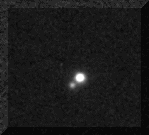
Pluto and its satellite, Charon
ECLIPSES
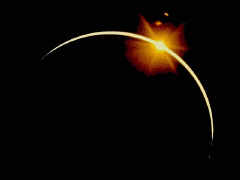
Solar Eclipse
When the Moon passes between
the Sun and the Earth a solar eclipse occurs; a lunar eclipse
occurs when the Earth passes between the Sun and the Moon.
Astrologers believe that prior to birth (between conception and the
first breath of life) there were at least two eclipses - one solar and
one lunar and that these prenatal eclipses have a
profound influence on an unborn child, and the energy pattern dispensed
during these eclipses follows you the rest of your life. The
magnetic pull of the Sun and the Moon eclipsing is strong enough to open
the Earth's sheath temporarily so that
these energies can be received.
At the time of the Solar
Eclipse the planet is seeded with the energy pattern that
correlates to the psychodynamics of the constellation the Sun is in at
the time.

Comments?
astdome@aol.com

|
|
NEPTUNE the
planet that rains 
 diamonds diamonds


Discover Magazine
September 2000
Unlike Earth, which has only a very
thin layer of atmosphere, a thick swath of gas surrounds Neptune's small
core. Last year, a team at the University of California at
Berkeley came up with a hypothesis about what might be occurring in the
planet's atmosphere to explain Neptune's extraordinary internal energy.
Robin Benedetti, a graduate student in physics, put some methane in a
pressurized chamber and used a laser beam to create "pressure and
heat conditions that you might find about a third of the way toward the
planet's center." Methane is composed of four hydrogen atoms
that surround a carbon atom. Benedetti found that under extreme
pressure the bonds holding the hydrogen atoms onto the carbon
dissolved, and the carbon atoms began binding to one another.
Under different conditions, carbon atoms would form a coal-like
substance, but under this extreme pressure, they formed diamond dust.
"We're not sure how big diamond crystals might form on
Neptune," she says, but they could conceivably make
the Krupp diamond on Elizabeth Taylor's finger seem like a chip.
If those conditions exist on Neptune, it's possible that diamonds are
literally raining down toward the planet's center, releasing heat as a
result of friction.
The Big Bang Theory 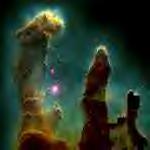
new
star nebula The idea that
perhaps the "Big Bang" is suspect
is starting to be realized and postulated by a few scientists and
astronomers. In a new magazine published by Scientific American
called the Magnificent Cosmos, there was an article by Andrei
Linde, a Russian- trained professor of physics now at Stanford. He championed
a theory of a self-reproducing cosmos, which is now being
studied for its merits. The universe (he postulates) started with one
small creative event, which then over a period of time led to another,
than another - explaining what we are actually seeing as we look out
with our telescopes, and also the paradox of age that was reported last
year when the Hubble telescope discovered stars at the edge of our known
universe that were younger than we were! If the Big Bang theory
was correct, they should have been the oldest. |
|
|
|
URANUS
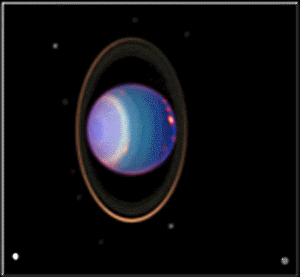
Spring on Uranus
is 21 years
If you lived on Uranus, spring would probably not be
your favorite season. Thanks to the Hubble Space Telescope, scientists
can study the planet's climate like never before. They came up
with some surprising results.
On Earth, spring is often considered a wonderful
season. The snow is melted, the grass is green and the
temperatures warm up. On Uranus,
spring signals a time of violent storms and cold temperatures.
There are hurricanes larger than half of
the United States, and the temperatures dip below 300 degrees
F!
While spring on Earth
lasts for a few months, it won't be summer on Uranus until the year 2007
because one Uranus year is equal to 84 Earth years!
The aquamarine face of
Uranus confirms the fact that Uranus is covered with clouds and the
sameness of the planet's appearance shows that the planet's atmosphere
is mostly composed of methane gas which traps the red light and does not
allow that color to escape. Beside clouds of methane crystals low
in the atmosphere, smog, composed of ethane (the fuel we use for
automobiles), is also present high in the atmosphere.
Life on Mars?
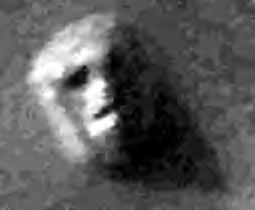
"The
Face" There is much
more to be gleaned from the Face Mesa. It is an oddity in more
than its resemblance to a face under the right light conditions.
It may be the Rosetta Stone for the terminal phase of Martian
Geology. That may be considered hyperbole by the non-geologists,
but the Face is one educational piece of
real-estate if you know how to read the words.
|